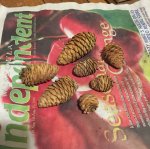Cerauno
Seedling
Hello! Let me start off by saying that I've set out on a very ambitious project; propagate at least one whitebark pine sapling from harvested pine cones.
• Why I Want Whitebark Pine:
- I moved to Montana several years ago and was struck by how beautiful this endangered (and naturally rare) species of pine tree was. The second I saw a stand of them on a barren mountaintop, I thought that they would make incredible bonsai. I became aware that the species was very much in decline, for several reasons* (listed below). This, and the fact that it's such a rare, yet ideal species for bonsai made me want to try and cultivate one or more.
• Harvested Cones:
- Luckily, my cousin has a tract of rural property on top of a rocky mountain with several small groups of healthy whitebark pines growing there. He gave me permission to take cones and cuttings from them, but I have only taken mature cones, as even on private property I'm not sure it's legal to take cuttings from an endangered species (I was unable to find anything online regarding Montana state laws for this, as is pretty typical for Montana).
- Last year exactly (late September, 2015), I collected 7 cones total from three different trees. From what I understand, whitebark pine cones don't really open at all on the tree, as the species largely relies on Clark's Nuthatcher for seed dispersal** (More on this below). Frankly, I forgot about them when I moved shortly after, and they've been in a paper bag for exactly a year, mostly at room or car temperature. I found the bag today and saw that the cones had opened on their own, and am very much hoping they may still be viable.
If they aren't good anymore, I can go take some more intact cones from the same location and prepare them over winter.
I'm pretty excited to see if growing a whitebark pine is possible. I've had several pine bonsai, and have propagated other species from seed and cuttings, but understand that all species of pine are apparently fairly difficult to grow from seed.
Any tips, advice, or info on the subject would be greatly appreciated.
• Why I Want Whitebark Pine:
- I moved to Montana several years ago and was struck by how beautiful this endangered (and naturally rare) species of pine tree was. The second I saw a stand of them on a barren mountaintop, I thought that they would make incredible bonsai. I became aware that the species was very much in decline, for several reasons* (listed below). This, and the fact that it's such a rare, yet ideal species for bonsai made me want to try and cultivate one or more.
• Harvested Cones:
- Luckily, my cousin has a tract of rural property on top of a rocky mountain with several small groups of healthy whitebark pines growing there. He gave me permission to take cones and cuttings from them, but I have only taken mature cones, as even on private property I'm not sure it's legal to take cuttings from an endangered species (I was unable to find anything online regarding Montana state laws for this, as is pretty typical for Montana).
- Last year exactly (late September, 2015), I collected 7 cones total from three different trees. From what I understand, whitebark pine cones don't really open at all on the tree, as the species largely relies on Clark's Nuthatcher for seed dispersal** (More on this below). Frankly, I forgot about them when I moved shortly after, and they've been in a paper bag for exactly a year, mostly at room or car temperature. I found the bag today and saw that the cones had opened on their own, and am very much hoping they may still be viable.
If they aren't good anymore, I can go take some more intact cones from the same location and prepare them over winter.
I'm pretty excited to see if growing a whitebark pine is possible. I've had several pine bonsai, and have propagated other species from seed and cuttings, but understand that all species of pine are apparently fairly difficult to grow from seed.
Any tips, advice, or info on the subject would be greatly appreciated.

